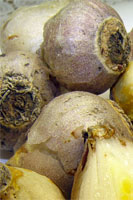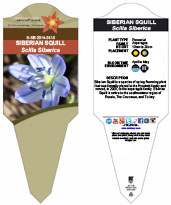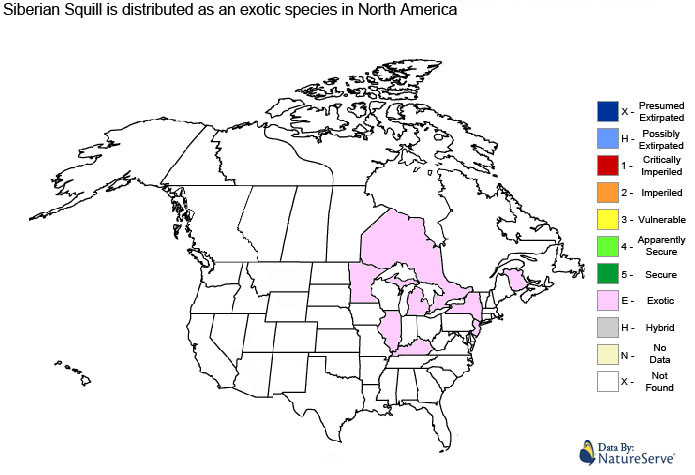Siberian Squill is a species of spring flowering plant that was formally placed in the Hyacinth family and moved, in 2009, to the asparagus family. Siberian Squill is native to the southwestern region of Russia, The Caucasus, and Turkey. The latin name of the genus scilla is named after the goddess Scylla of Greek mythology, a beauty who was tuned into a terrible sea monster. The species name siberica is named after 'Siberia' even though despite its name it is not native to Siberia. Due in part to the naming of the species after a greek mythological character, many superstitious people have viewed siberian squill as a flower associated with witches and evil spirits and have avoided the plant as much as possible.
Siberian Squill is an ingredient in certain rodent poisons.
Within the realm of rational and holistic medicine, there is currently no historical, or current, uses for siberian squill.
Please note that MIROFOSS does not suggest in any way that plants should be used in place of proper medical and psychological care. This information is provided here as a reference only.
Siberian Squill is considered to be poisonous and should not be consumed.
Siberian Squill is a spring perennial which can grow from 10cm to 20cm tall and 5cm wide from a purple bulb. Each bulb produces two to four subulate leaves with parallel venation. As the leaves grow, a blue radially symmetrical flower develops on a single stem. Each flower has six petals and six stamens, and are arranged singly or in racemes of two or three. Petals may be reflexed to the horizontal when sunlight is bright, but are more often cup-shaped. The flowers are usually blue, but there is a variety of siberian squill (scilla siberica-alba) which bloom white. The pollen from siberian squill is dark blue and is transported primarily be bees, as well as other insects. After flowering, the flower stems become limp as capsules (pods) mature. At maturity, the capsules become purple and split open, releasing small, dark brown seeds. When the seeds are mature, the leaves wither and the plant goes dormant until the next spring.
| Plant Height |
10cm to 20cm |
| Habitat |
Forests, Thickets, Clearings, Lawns, Gardens |
| Leaves |
Subulate |
| Leaf Margin |
Entire |
| Leaf Venation |
Parallel |
| Stems |
Smooth Stems |
| Flowering Season |
April to May |
| Flower Type |
Radially Symmetrical |
| Flower Colour |
Blue or White |
| Pollination |
Bees, Insects |
| Flower Gender |
Flowers are hermaphrodite and the plants are self-fertile |
| Fruit |
Hard round purple seeds |
| USDA Zone |
3B (-34°C to -37°C) cold weather limit |
The following health hazards should be noted when handling or choosing a location to siberian squill:
 |
TOXIC
Siberian Squill is considered to be toxic.
|
 |
-Click here- or on the thumbnail image to see an artist rendering, from Tele Botanica, of siberian squill. (This image will open in a new browser tab) |
 |
-Click here- or on the thumbnail image to see a magnified view, from Mariluna, of the bulbs created by siberian squill for growth and propagation. (This image will open in a new browser tab) |
Siberian Squill can be referenced in certain current and historical texts under one other name:
Siberian Squill can be translated into the following select languages:
| Arabic |
بصل الفار سيبيريا |
Bulgarian |
Сибирски синчец |
Chinese (Sim) |
西伯利亚海葱 |
| Croatian |
Sibirski morski luk |
Czech |
sibiřský squill |
Danish |
sibirisk squill |
| Dutch |
Siberische squill |
Esperanto |
|
Estonian |
Siberi squill |
| Finnish |
siperian squill |
French |
scille sibérien |
German |
Sibirische Blaustern |
| Greek |
Σιβηρίας σκίλλης |
Hebrew |
חצב סיבירי |
Hungarian |
szibériai csillagvirág |
| Italian |
scilla siberiano |
Japanese |
シベリア海葱 |
Korean |
시베리아 스퀼 |
| Punjabi |
|
Lithuanian |
Sibiro scylė |
Norwegian |
|
| Persian |
|
Polish |
|
Portuguese |
|
| Romanian |
|
Russian |
сибирский морской лук |
Slovak |
sibírsky squill |
| Spanish |
squill siberiano |
Swedish |
|
Tagalog |
Siberya skpil |
| Turkish |
Sibirya adasoğanı |
Ukrainian |
Сибірський морський лук |
Vietnamese |
cây hải song siberian |
| The information provided in this conservation assessment has been provided by the Natureserve Database in conjunction with various federal, provincial, state, county, district, regional, and municipal governments as well as public and private conservation authorities. Information in this section is accurate from the last time this article was updated. |
 |
Siberian Squill has no conservation status as it is considered an exotic and or invasive species in North America. |
 |
The MIROFOSS database offers free printable garden tags for personal and non-profit use. These tags can be used to properly identify plant samples in a garden. Click on the tags shown on the the screen or -click here- to download a full size jpeg image for a siberian squill identification tag; which can be printed on paper or used with a plastic laser printer. |
 |
What's this?
This is a QR code (short for Quick Response) which gives fast-track access to MIROFOSS articles. QR Codes are barcodes that can be read by smart phone cameras. This QR Code is unique to this MIROFOSS article.
What can I do with it?
You can copy and print the QR code to a plant label, poster, book, web site, magazines, or newspaper so smart phone users can scan the QR Code which automatically takes them to this specific article.
|
| Description |
RHS A-Z encyclopedia of garden plants. United Kingdom: Dorling Kindersley. 2008. p. 1136. ISBN 1405332964.
|
| Description |
Kartesz, J.T. 1994. A synonymized checklist of the vascular flora of the United States, Canada, and Greenland. 2nd edition. 2 vols. Timber Press, Portland, OR. |
| Folklore |
Harrison, Lorraine (2012). RHS Latin for gardeners. United Kingdom: Mitchell Beazley. ISBN 9781845337315. |
| Image Rendering |
USDA-NRCS PLANTS Database / USDA NRCS. Wetland flora: Field office illustrated guide to plant species. USDA Natural Resources Conservation Service. |
| Environment |
National Audubon Society. Field Guide To Wildflowers (Eastern Region): Alfred A. Knopf. pp 415-420 ISBN 0-375-40232-2 |
| Physical Identification |
National Audubon Society. Field Guide To Wildflowers (Eastern Region): Alfred A. Knopf. pp 415-420 ISBN 0-375-40232-2 |
| November 01, 2015 |
The last time this page was updated |
| ©2021 MIROFOSS™ Foundation |
|




















